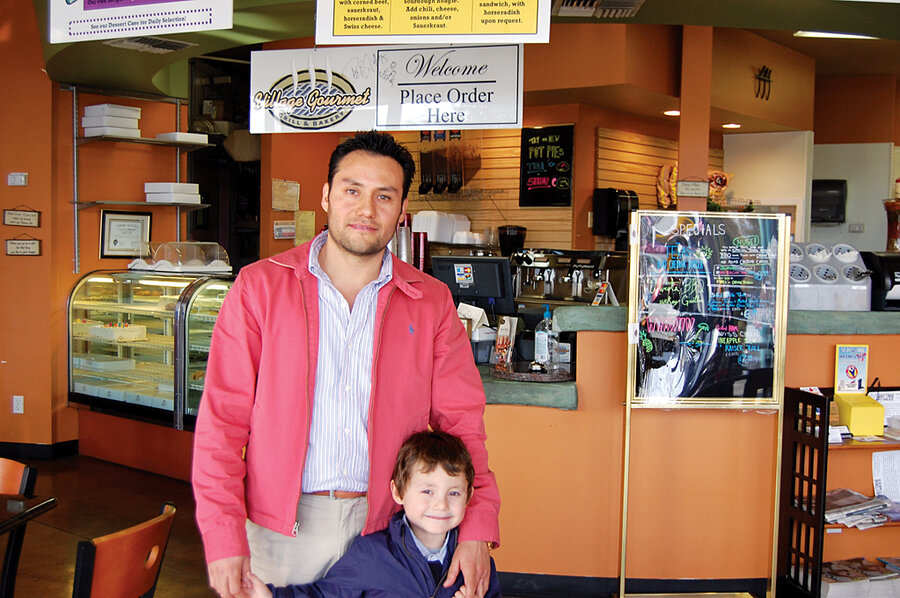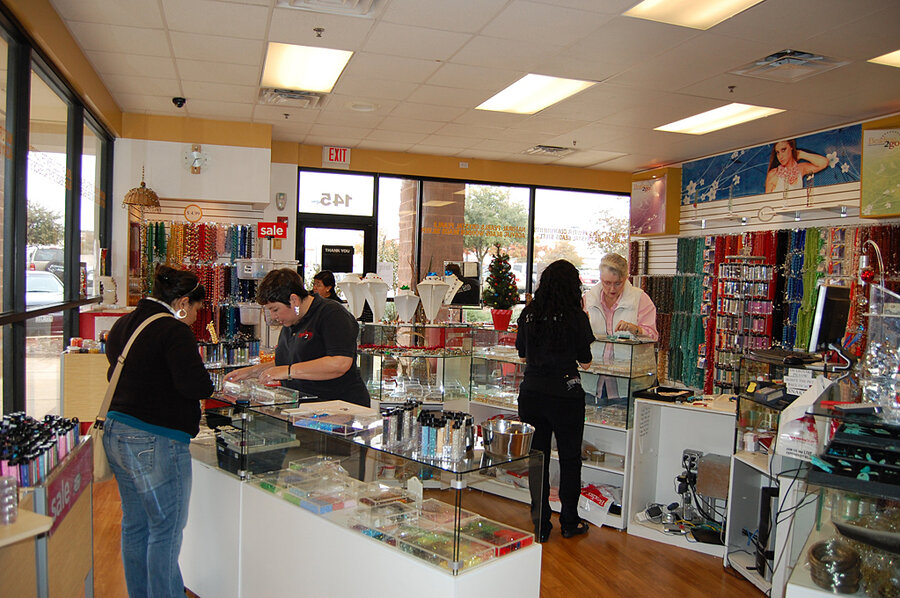Who’s creating US jobs? Mexicans.
| San Antontio
For Pierre Gama, the fourth kidnapping was the final straw. Armed carjackers made him drive his car in circles until he gave them the numbers to his credit cards. With two small children and a wife – who was with him during one such secuestro express – the security entrepreneur wanted out of Mexico City.
Mr. Gama proposed moving to Canada, but his wife said it was too cold there. So he opted for an escape route a growing number of his wealthiest countrymen are taking: He bought his family’s way into the United States by spending about $200,000 on a San Antonio restaurant and catering business.
It’s perfectly legal. Immigrants can bring in family on an EB-5 visa if they invest $500,000 to $1 million in a US business. Mexicans have a cheaper deal via E-1 and E-2 visas, thanks to a treaty with the US. Gama took a similar tack, buying Village Gourmet and transferring himself to the US as its new executive via an L-1 visa, designed for intercompany executive transfers.
“The misfortune for Mexico [is the] fortune for the United States,” says Irene Kegan, executive director of the Mexican Business Association in San Antonio.
As Mexico’s drug wars escalate, businessmen and families have become a natural target for traffickers looking to extortion to finance their operations, says Art Martinez de Vara, a San Antonio-based immigration lawyer. Some 17,000 people have been killed in drug violence since President Felipe Calderón took office in December 2006 and vowed to take on the drug traffickers.
In fiscal year 2008, the US issued E-1 and E-2 visas to 1901 Mexicans and their families, nearly three times the level of a decade before. (See chart at left.)
The natural target for Mexican immigrant investors? San Antonio.
“San Antonio just came out ... as probably one of the best cities to invest in,” says Alfredo Lozano, an immigration attorney who works in the same law firm as Mr. Martinez. It’s close to Mexico but considered less dangerous than cities like Brownsville and Laredo.
That’s what attracted Ricardo del Rio.
“Very Mexican, very friendly. Quiet. I call it ranch,” says the polite and precise insurance agent, who got E-2 visas for his family at the end of 2006.
He turned down a job in Miami – concerned his family wouldn’t feel at home with the diverse Latino communities there. Setting up shop in California would have cost him three times as much, he adds.
But Mr. del Rio might not be here much longer. His visa business plan called for hiring seven people over five years in his insurance business, and that’s yet to happen. He has two more years to make good on that proposal – and thinks he may hire a handful – or he won’t be able to renew his visa and he and his family will be forced to leave the US – an unsavory prospect. “I wanted to be out [of Mexico] before something really bad happened,” he says.
Jewelrymaker moves to San Antonio
As a third-generation jewelrymaker, opening a beading store was natural for one Mexican immigrant (who declined to give his name for security reasons). He has about 40 bead stores in Mexico now and was already employing jewelrymakers as a college student.
But crime pushed the enterprising Mexican here. His Mexican stores were robbed 18 times last year, he says. He’d had four robberies in all the years beforehand.
He’s opened three Beading2gos in the San Antonio area in the past two years. On a December Sunday, two bilingual employees fluttered amid a stream of clients in the make-your-own-jewelry shop.
“Ah! You guys are hiring!” says a grandmotherly woman making a tiny bracelet for a baby shower, pointing to a help wanted sign.
“Si, de veras,” the staffer responds. It’s a permanent position, says the owner, who employs about a dozen people in these shops in which he invested initially about $175,000 in stock and $45,000 in remodeling. He and the co-owner, his wife, bought a house here two months ago and plan to open a fourth store soon either in Texas or Arkansas. (Why Arkansas? “It’s lovely!” he says of Little Rock.)
He came at the invitation of the city of San Antonio, which runs an international affairs department that reaches out to potential Mexican immigrant investors.
“What we are doing is offering the American companies to find Mexicans,” says Luis Escobar, owner of EGA Direct, a private consultancy that similarly reaches out to potential immigrant investors. He moved to San Antonio after being kidnapped twice in Mexico. He estimates that 80 percent of his clients want to move for security concerns. “I have a client without a foot. I have a client without a finger. We have clients without one member of the family,” he says.
The State Department does not yet have data for how many Mexican immigrant investors came in fiscal year 2009. But recent events may have stoked the movement further: After the widely publicized 2008 “Martí case” – in which a prominent businessman’s adolescent son was kidnapped and killed, despite the family having reportedly paid millions in ransom – Mr. Escobar says online inquiries increased from eight monthly to up to 40.
Escobar says none of his clients have had their visa requests turned down, but he’s selective. He refuses to take inquires from investors in states like Sinaloa and Chihuahua. “The probability that we ... find out a wealthy person in those states [is related to the drug trade] is very high,” he says.
Bought restaurant, now expanding
Gama’s life has taken a turn for the better since leaving Mexico last summer. He plans to open another Village Gourmet this year. He’s made some updates to the place, increasing online advertising and adding a few new hamburger dishes. But the most popular dish is still chicken potpie, he says. The menu claims it sells 650 a month.
In the airy restaurant wedged in a sprawling stuccoed shopping center next to a Walgreens pharmacy and within walking distance of Barbara Bush Middle School, son Emilio plays on his lap and asks for his mom. Gama explains that his wife hasn’t come yet. Her common name was too similar to others with criminal backgrounds, delaying her visa. She was still living in Mexico City in December.
They’re renting an apartment now in San Antonio. Does he want to bide his time until he can return safely to Mexico or stay in Texas? “Yes, yes,” he answers to the second.
“Little by little, the idea is that we’re going to sell what we have there, the properties we have,” Gama says in Spanish. “And little by little, make this change.”







